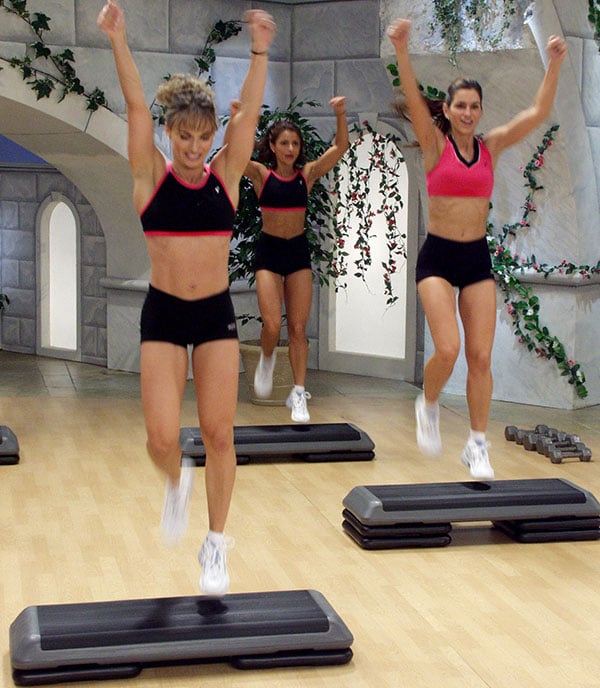
Types of Circuit Workouts
You can do circuit workouts in several ways. One way is to alternate resistance exercises with bursts of cardiovascular exercise. The first circuit would be a resistance exercise followed by a cardio exercise during the second circuit. Then alternate back and forth. Using this mode of circuit training will give you a good cardiovascular workout.
Another way to structure a circuit workout is to do a resistance exercise during each circuit (no cardio circuits) with little or no rest between circuits. By resting minimally between resistance circuits, your heart rate will be higher than during traditional strength training – but is it high enough to give you cardiovascular benefits? In other words, can you get a cardiovascular workout doing resistance training circuits only?
Circuit Training Benefits: Do Circuit Workouts Offer a Cardiovascular Workout?
If you’re doing cardiovascular segments during a circuit workout, you’re obviously getting cardiovascular benefits because you’re bringing your heart rate up during the cardio circuits. The question is whether resistance training circuits alone boost your heart rate enough to qualify as cardio.
One study showed circuit workouts without cardiovascular circuits does offer cardiovascular benefits. Participants in this study performed 10 repetitions of 10 different resistance exercises using a resistance equivalent to 40% of their one-rep max, the maximal amount of weight they could lift one time. The only rest they took between exercises was the time it took to change exercises. The exercises alternated between upper and lower body movements.
Using this circuit training protocol, without cardiovascular exercises, the participants experienced heart rate increases and changes in oxygen consumption sufficient to give cardiovascular benefits. The conclusion? You can get cardiovascular benefits from circuit workouts using only resistance circuits if you rest minimally between circuits. This should come as no surprise if you’ve done circuit workouts before and noticed how winded you feel afterward. Plus, it’s a lot more fun than doing 30 minutes of straight cardio!
The Pros and Cons of Circuit Training
Combining cardio and resistance through circuit training is a real timesaver. Circuit training can be a good addition to your fitness training, especially on days when you have limited time to exercise – but keep this in mind. If your primary goal is to build muscle mass or strength, circuit training may not offer enough of a stimulus to make your muscles grow. During a circuit workout, you’re using lighter weights and aren’t overloading your muscles enough to make large gains in muscle mass or strength.
Circuit training workouts are best for overall conditioning, functional strength and muscle endurance. During a circuit workout, you increase your heart rate, burn fat and work all of your muscle groups but you won’t maximize any one of these. If your goal is to build strength and lean body mass, you still need to work out with heavier weights. On the other hand, there’s no reason you can’t circuit train on some days. It’s a good way to add variety to your routine and work on general conditioning. Another advantage is you’ll burn more calories during a circuit workout due to the quick movement between circuits than you will with traditional strength-training.
Circuit Training and the Interference Effect
One problem you could encounter if you do circuit training workouts too often is the “interference effect.” When you’re doing strength workouts using heavier weights, you’re developing fast-twitch muscle fibers, the kind that grows in response to strength and power exercises. Circuit training using lighter weights works mainly slow-twitch fibers, the kind you need for muscle endurance. When you do both, you’re sending your muscle “mixed messages,” asking it to adapt in different ways. You may sacrifice some strength and hypertrophy gains if you do both types of workouts on a regular basis. If you’re not trying to build lean muscle mass or become stronger but just want to achieve a higher level of conditioning, circuit training is your ticket.
The Bottom Line?
You can get cardiovascular benefits from circuit training without doing cardio circuits if you move quickly from resistance exercise to resistance exercise. Because you’re working with lighter weights, you probably won’t achieve the same degree of muscle development as you would with standard strength or hypertrophy training. On the other hand, circuit training is a great boredom buster and timesaver because you work your cardiovascular system, improve muscle endurance, and functional fitness all at the same time. How often you do circuit workouts should depend upon your goals.
References:
IDEA Health and Fitness Association. “New Insights Into Circuit Training”
“New Insights into Circuit Training” Len Kravitz Ph.D.
Journal of Strength and Conditioning Research 18(4). 760-764.
Clinical Interventions in Aging. “Effects of circuit-based exercise programs on the body composition of elderly obese women”
Related Articles By Cathe:
Can You Build Muscle Mass and Strength with Circuit Training?
5 Powerful Reasons to Do a Circuit Workout
Are You Making These Circuit Training Mistakes?
Related Cathe Friedrich Workout DVDs:

